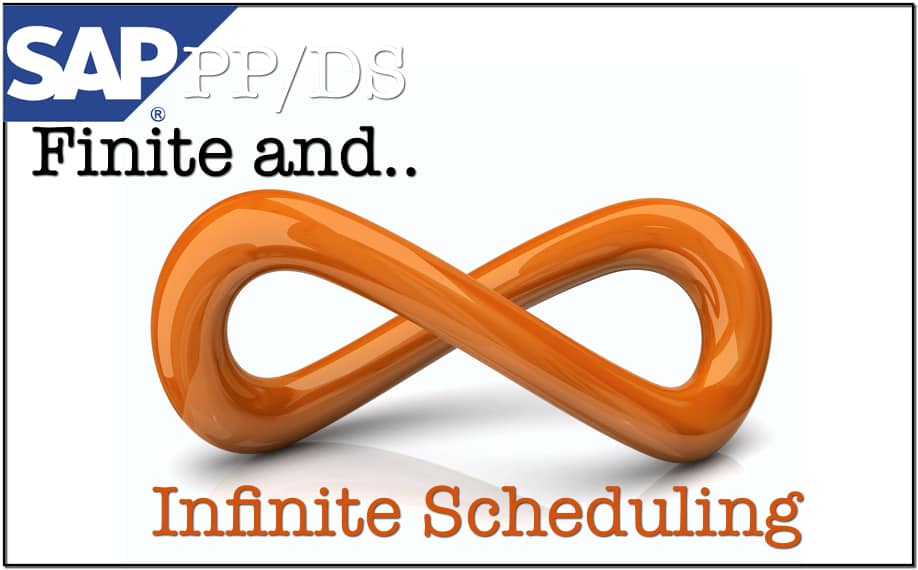Finite and Infinite Scheduling in PP/DS
Executive Summary
- PP/DS finite scheduling and its issues
- Resource maintenance
- The problem with how many large consulting companies like IBM approach discussing constraints with the client.
- Being in constraint denial
Constrained or Unconstrained Detailed Scheduling
It’s essential to consider and evaluate the use of the sentence
PP/DS performs finite based scheduling.
The reason it is crucial to assess the comment is for several reasons:
- PP/DS can be run in either finite or infinite mode for scheduling.
- The value that is entered in the PPMs or PDSs may be “placeholders.”
- The constraint values may be incorrect when the project goes live or may start as an accurate reflection of factory constraints and then drift from their initial accuracy due to an inability to maintain this master data.
Our References for This Article
If you want to see our references for this article and other related Brightwork articles, see this link.
Notice of Lack of Financial Bias: We have no financial ties to SAP or any other entity mentioned in this article.
Constrained?
I once had a bizarre conversation with a consultant who, in a meeting with S&OP, proposed that one way or another, the plan would be constrained because the PPMs would have to have values in them for resources to “activate.” When I pointed out that these values were not necessarily accurate, he agreed for a moment, but then reverted to his initial track of talking about the constrained plan that would be sent to S&OP.
Configuring for Yourself, Not for the Client: How IBM Does Things
I have this experience relatively frequently with consultants from the big consulting firms as they typically like to configure software regardless of its benefit to the company as it is a method for enhancing their resume. This particular consultant worked for IBM, but all the big consulting companies have moved in this direction. With the increasing focus on technical wizardry for its own sake, fewer and fewer SAP consultants understand the businesses they are configuring the system for. It also results in less and less sustainable solutions for clients. I frequently run into mis-designed solutions that were based upon the need for padding billing hours and resume building needs of the consultant by the major consulting companies with increased frequency. You can read more about these issues at the link and this link.
Misunderstood Constraints on a Previous Project
On another project, I evaluated their PP/DS installation that they thought was constraining the plan, only to find that the PPM resources were set to infinite capacity and that the only constraint was a lot size.
Finite Scheduling Indicator
Resources can be checked for whether they are constraining or planning finitely by checking the resource master and looking for the finite scheduling indicator. If this indicator is not set, the resources are not constraining. Furthermore, resources can be configured with a “finiteness level.” This means that the resource can be treated as variably finite depending upon the application (i.e., infinite for PP and finitely for DS). Additionally, finite or infinite scheduling can be set in the global PP/DS settings.
It took over four meetings with business representatives who did not believe me because they said that what I said could not be true because SAP had explicitly told them this is what PP/DS did, and that…
…PP/DS does constraint based planning.
My response was that…
PP/DS has the capability to do constraint based planning, but it must be configured properly to do so.
SAP was effectively hiding this fact from the client, but what the business could not figure out was why their production plan was so unusable. SAP eventually had the analysis into this area buried. The production plan was still ignored by the factory, but the implementation problems were blamed on the business, which was “clueless” and did not “get it.” However, all they had to do is check the SAP documentation, where it clearly states that finite scheduling is only one way of running PP/DS.
The Many Problems with PP/DS
There are many reasons for PP/DS implementations not to meet expectations. However, one of the most common is companies have a great deal of difficulty in keeping their resources and PPMs up to date with the actual resource capacities in the factory. There are two aspects to this problem. One is the lack of investment many companies make in their resource maintenance, which is independent of the software. However, the other issue is how easy the master data is to maintain in the system, and this differs greatly depending upon the application, with resource data in SAP APO being one of the more challenging to manage comparatively.
The fact is that MDM will not ride to the rescue on maintaining PPMs and resources and that the method that SAP has provided to the maintenance of this master data is a significant burden on the company to manage. This is why I recommend that companies not get too excited after they take a module live because the real proof of the maintainability of the systems is several months after go-live.
